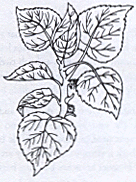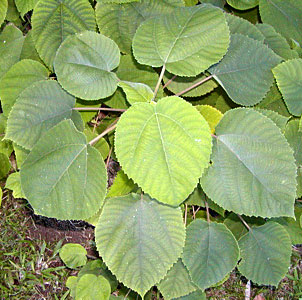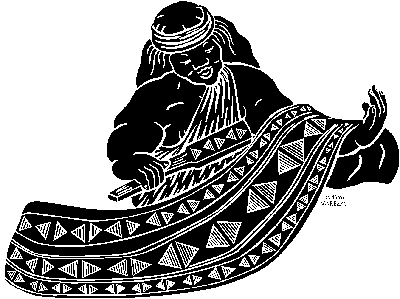Canoe Plants of Ancient Hawai`i Home - Intro - Contents - Bibliography - Links - Credits `Ape - `Awa -`Awapuhi -Hau -Ipu -Kalo -Kamani -Ki -Ko -Kou -Kukui -Mai`a Milo -Niu -Noni -`Ohe -`Ohi`a `Ai -`Olena -Olona -Pia -`Uala -Uhi -`Ulu -Wauke |
Canoe Plants of Ancient Hawai`i Home - Intro - Contents - Bibliography - Links - Credits `Ape - `Awa -`Awapuhi -Hau -Ipu -Kalo -Kamani -Ki -Ko -Kou -Kukui -Mai`a Milo -Niu -Noni -`Ohe -`Ohi`a `Ai -`Olena -Olona -Pia -`Uala -Uhi -`Ulu -Wauke |
 Imagine the days when all of the cloth that was worn as garments, slept under as bedding, used for ceremonial occasions, wrapped around the `iwi (bones) of the ancestors, every imaginable use we now have for loomed fabric...all of this cloth came from the inner bark of trees, the most cultivated and useful of which is wauke, the paper mulberry tree. Wauke is also known as Broussonetia papyrifera, and is a member of the fig (Moraceae) family. It is the principle plant used in the making of kapa, or tapa cloth. Kapa means the beaten thing. One of the principle plants introduced by early voyaging Polynesians who settled here in Hawai`i, wauke is thought to have been carried in the canoes as root shoots, but can also be grown from cuttings and occasionally by seed.
Imagine the days when all of the cloth that was worn as garments, slept under as bedding, used for ceremonial occasions, wrapped around the `iwi (bones) of the ancestors, every imaginable use we now have for loomed fabric...all of this cloth came from the inner bark of trees, the most cultivated and useful of which is wauke, the paper mulberry tree. Wauke is also known as Broussonetia papyrifera, and is a member of the fig (Moraceae) family. It is the principle plant used in the making of kapa, or tapa cloth. Kapa means the beaten thing. One of the principle plants introduced by early voyaging Polynesians who settled here in Hawai`i, wauke is thought to have been carried in the canoes as root shoots, but can also be grown from cuttings and occasionally by seed.
The ancient practice of making bark cloth and bark paper likely began in Asia, where other species of Broussonetia are known; yet, in Polynesia, Broussonetia papyrifera reigns supreme. The quality of its cloth is prized and valuable, warm, water resistant, long lasting, washable, soft, mothproof, flexible and white. In Polynesia, the loom and weaving of fibers did not occur, possibly because there were no mammals of size to provide hair. Cotton, flax, hemp and silk were not produced.
 Wauke grows best in moist areas, along streams, in forests, wherever soil is rich, and where there is protection from the wind. Usually a small tree or shrub, wauke can grow as tall as 50 feet, but in cultivation, the plants were kept small. Nurtured and carefully tended by both men and women, wauke was grown around the lo`i, taro pond fields, and near home sites in thick stands of 8-9 foot tall trees. Keiki grow from roots of established plants, so the wauke grove extends outwards naturally.
Wauke grows best in moist areas, along streams, in forests, wherever soil is rich, and where there is protection from the wind. Usually a small tree or shrub, wauke can grow as tall as 50 feet, but in cultivation, the plants were kept small. Nurtured and carefully tended by both men and women, wauke was grown around the lo`i, taro pond fields, and near home sites in thick stands of 8-9 foot tall trees. Keiki grow from roots of established plants, so the wauke grove extends outwards naturally.
As the wauke tree grew, planters cut off the side branches, so a straight trunk stalk without branch holes could later be stripped. In 6-10 months the trunk shoots were cut down and the roots and tops removed. The trunks were stripped of bark, as thick as a finger and about 4 feet long. The outer bark was slit and peeled off. The inner bark fibers, called bast, were then soaked in running water, such as a high tide pool, with stones placed on top of the fiber pile. This part of the process breaks down the woody fibers and washes away the starch. A complicated process of soakings and fermentation followed, leaving the fine fibers of the moist inner bark still tough and resilient when finally removed from the waters. At this time in the process, the women of Hawai`i would often twist cordage out of the fibers, for use as fish nets, upena, and as carrying nets, koko, from which to hang calabashes of wood and gourds.
The women then spread the strips of inner bark to be used for cloth into several layers, all of the same thickness. After the water was drained away, the fibers began to stick together and the entire bundle could be lifted as one mass. This was called mo`omo`o. It was beaten on smooth rocks and sun dried. Mo`omo`o was then often stored until enough material had accumulated to make a large piece of kapa cloth. When enough mo`omo`o bundles were accumulated, these were soaked for half a day, then pounded gently to loosen the fibers. They were then laid between layers of mai`a, banana leaves, for a week to mature and ferment, making the fibers softer, almost like the leavening process in bread making. These cakes of wauke were then kneaded until elastic. When ready, the women laid the bundle on a long piece of wood with a flat even surface, an anvil called kua kuku. Then the women beat the pulp with a simple heavy mallet, a wooden beater called hohoa, until a solid strip formed. The beating established a rhythm with resonating sounds, which often sent secret codes rapidly from village to village. After this, the strips were soaked again. The cloth expanded greatly with each beating. It was often doubled over and beaten again. The first beating was called ho`omo`omo`o, the second kuku, and the third ho`oki.
Most wooden beaters, i`e kuku, used in the final stage, were four-sided, made from `ohi`a wood, carved and incised with stamps in intricate geometric designs and patterns. The kapa maker left her "watermark" imprinted on both sides of the kapa she made. These can be seen by holding the kapa up to the light.
At this point in the process, the cloth was hung in the sun to dry and to bleach whiter. The quality of the kapa varied according to the bark quality and the skills of the maker. Most i`e kuku were made from kolea wood.
After the kapa was completed, intricate designs were added to some of the cloth with dyes and a high quality of colored stamped patterns. These were unique to Hawai`i and are considered a lost art form, although in the last 15 years a few people have resumed the making and stamping of kapa in the old way, renewing this lost art. Kapa means the beaten.
The beaters, anvils and stamps were made by the men of the village. The dyes came from varied natural plant sources. Pigmentation comes in many colors, predominantly black, from burying the cloth in the mud of a kalo lo`i, brown from such as kukui root bark and red from its bark, yellow and orange from the tuber of `olena, red from noni's bark and yellow from its root. The dyes, waiho`olu`u, were fixed to the cloth with mordants of salt/pa`akai, urine/mimi, mud/lepo, and coral/ko`a. Some dyeing was by immersion/ho`olu`u. Geometric designs with inherent symbolism, such as lines, triangles, circles and chevrons were imprinted using stencils and stamps usually carved in `ohe, bamboo. The printers were called `ohe kapala. `Ohe was also used for brushes, as were dried hala drupes (fruit). Sticky adhesives were used to waterproof kihei, capes. Some kapa was scented, usually that which was to be stored. Aromatic oils, seeds and flowers of such as maile, mokihana, `awapuhi, `iliahi/sandalwood, hinano and kamani flowers were applied.

The clothing made were a wrap, kikepa; a knee length wrap-around skirt called pa`u (pareau, sarong, lava lava), the principle garment for women of early Hawai`i; loin cloth, malo, for men; sandals, hula costumes, and the kihei, or cape.
Bed clothes were kapa moe, single sheets of kapa, placed together for warmth, a modern double-bed size. Also, kapa ku`ina, several layers stitched along one side with wauke cordage, was used in colder climates. The top layer was called kilohana, usually decorated and/or dyed.
There are two existing forms of paper mulberry. Wauke, of superior quality, and po`a`aha, which produces very thin sheets of kapa. The plants are similar, except for the leaves. Those of wauke are thick and rough on top, woolly underneath and are lobed. The leaves of po`a`aha are velvety soft and rounded. The leaves of both plants are heart shaped with serrated edges, and are 4-6 inches long by 3-5 inches wide. The flowers are rare and sparse, fuzzy, one inch round with hairy bracts and long stigmas. Fruit are rare, and are orange and one inch round.
Other sources for kapa fibers are mamake, a species of pipturus, which produces a dark fiber. Ma`aloa also produces brown fibers. Other occasional sources are po`ulu and mamane.
Medicinally, the slimy sap of wauke is a mild laxative. `Ea, thrush, a mouth disease, is said to be improved when the ash from burned kapa made from wauke is applied to the mouth.
Kapa figured in several Hawai`i legends, one of which is about the god Maui and his mother, the goddess Hina, and how he lassoed the sun from Haleakala to slow down the day, so it would be warm long enough to dry his mother's kapa cloth.
There were a great abundance of wauke plants grown in Hawai`i prior to the introduction of foreign fabrics, but now this once cherished plant is rarely to be found.
Mulberry-bark fabric was an ingenious adaptation
The Honolulu Advertiser, Friday, November 17, 2006
| Canoe Plants of Ancient Hawai`i Home Intro - Contents - Bibliography - Links - Credits `Ape -`Awa -`Awapuhi -Hau -Ipu -Kalo -Kamani -Ki -Ko -Kou -Kukui -Mai`a |